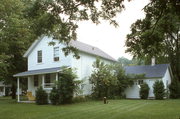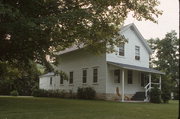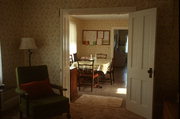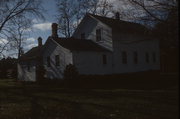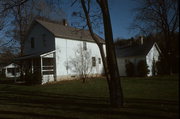| Additional Information: | Peter Peterson was one of Ephraim's leading merchants. Since 1882, this house has served as a parsonage of the Free Evangelical Lutheran Church. Born on a farm in Norway in 1821, Peterson emigrated to Canada in 1846 and two years later settled in the forests southeast of Green Bay where he helped form the community of New Denmark. While living there, Peterson met the Rev. Andreas Iverson, the Moravian leader of Ephraim, who stayed with Peterson during the difficult winter of 1855. Encouraged by Iverson, Peterson moved to Ephraim in the autumn of 1856, built a house, started a freight service, opened a store, and together with Aaslag Anderson, bought 150 acres of Ephraim's lakefront for the construction of the village's first pier. Despite this early business success, Peterson moved to Green Bay during the Civil War and relocated to Sturgeon Bay in 1870. But in 1871, Peterson returned to Ephraim "where he bought a piece of land...with a small house on it, built a store...and set up business" in the community. Soon after his return, Peterson built a second wharf, now demolished, in the southern part of the village where boats loaded local products like firewood, fence posts, telegraph posts, bark, and railroad ties. In addition, Peterson conducted an active wholesale business in both groceries and dry goods, selling items that ranged from hardware to farming implements, from prefabricated doors to medical supplies to grain. The house that Peterson built in 1874 served as both his house and a storehouse for the stock of his trade. Peterson's central role in the community was reflected in the civic positions he held. Peterson served variously as town chairman, justice of the peace, and notary public. During the 1870s and 1880s, Peterson was the leading force in the establishment of the Free Evangelical Lutheran Church. His money helped pay for the construction of a building and his influence helped steer the new congregation clear of any synodical affiliation. So closely was Peterson identified with the Lutheran church that Iverson, once a friend, eventually considered Peterson his chief rival. As a gift to the Lutheran congregation, upon his return to Norway in 1883, Peterson deeded his house for use as a parsonage. Since then, the house has served as a residence for the congregation's pastors and has been intimately tied to the history of the church. Peterson's autobiographical narrative, written in a fictionalized form as "A part of Per Hagen's Journay", was serialized in a Norwegian newspaper in 1901 and published in translation by the Norwegian-American Historical Association in 1984. |
|---|
| Bibliographic References: | "75th Anniversary of Bethany Lutheran Church, Wisconsin, 1882-1957" pamphlet.
Kahlert, John, Pioneer Cemeteries (Baileys Harbor, WI, Meadow Lane Publishers, 1981).
Peterson, Peter, On Both Sides of the Ocean: A Part of Per Hagen's Journey. Translated with introduction and notes by Kate Stafford and Harold Naess. (Norwegian-American Historical Society: Northfield, MN, 1984), pp. 4, 17, 38-41, 47, 48-51, 59-64, and 68. |
|---|

